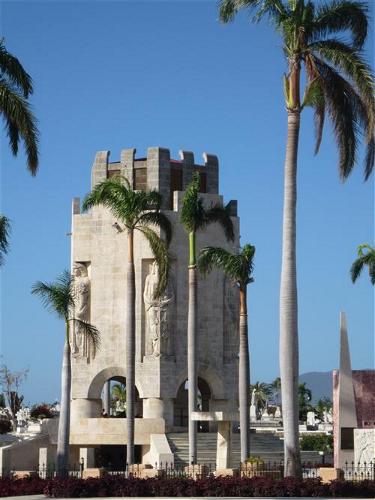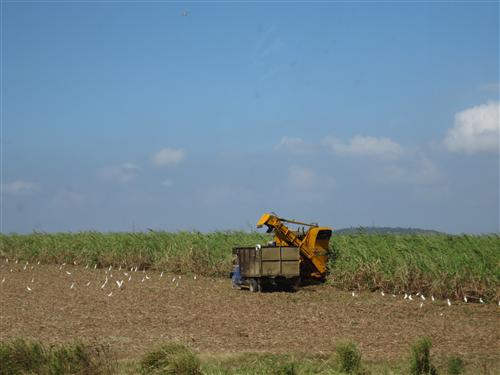Today was our departure day, and we left Santiago for the airport in Holguín. We first stopped at a cemetery in town to see the Mausolem of José Martí. This visit could not have been planned better as we coincidentally arrived at the moment when the changing of the guard was taking place.

Along the way we stopped at Finca Manacas, the birthplace of Fidel Castro, which is located just outside of Birán. The house, a bit startling with its bright yellow paint and blue accents, has a layout typical of many Caribbean manors. Large double doors open wide into a central hall that runs to the back of the building, which also opens up, allowing for maximum cross ventilation. Two rooms are located off of each side of the central room. Like other Caribbean and Southern U.S. dwellings, the main living quarters are raised above the ground.

Out near the front of the complex are bohíos, traditional Cuban thatched huts. The walls are made of supports with strips woven through and the structure is capped with a pitched roof made of thatch from the royal palm. This is where the workers of the farm, who were often immigrants, lived.
Sadly, our next stop was the airport in Holguín. Though we had said our thanks and made some toasts at the farewell dinner the night before, some things deserve to be repeated in this blog. All of us on the trip are indebted to Monty for organizing this trip and sharing his knowledge with us. He took us places that no other trip would ever go, evidence of his longstanding love for discovering the architectural treasures of this island. Likewise, we are thankful to SAH for sponsoring this trip. We were told that this trip sold out in only 6 or 7 minutes and there were no problems filling the second trip as well. All of us who were lucky enough to secure a spot on the trip and experience this adventure now see that the demand for this trip was well deserved. On a personal note, I am very grateful to have had the honor of participating on this trip as the student fellowship participant. I met intelligent, wonderful people on the trip with whom I had the privilege of sharing these experiences and exchanging thoughts about what we encountered. I visited sites and buildings that I would not be able to gain access to were I traveling on my own, and the cost of a trip of this scope is something a graduate student like myself could only dream of undertaking sometime in the distant future. As I look forward to finishing my degree in the near future I know that this trip—the experiences, the new friends, the knowledge gained—will be a highlight of my graduate student experience and will help me define myself in as I look toward my personal and professional future.
 Erica N. Morawski, Ph.D. Candidate, University of Illinois - Chicago
Erica N. Morawski, Ph.D. Candidate, University of Illinois - Chicago
Erica N. Morawski is a Ph.D. candidate in art History at the University of Illinois – Chicago. She received a BA in art history at Tulane University and MA in Art History at the University of Texas at Austin. She is currently completing a dissertation entitled, “Designing Destinations: Hotel Architecture, Urbanism, and American Tourism in Puerto Rico and Cuba.” This work investigates the role of hotels in shaping understandings of national identity, which in turn shaped international relationships, through an approach that systematically ties object and image analysis with social, political, and economic histories. Her work argues that these hotels functioned, and continue to function, like diplomatic cultural attachés—their design shaped politics on the islands, and played a decisive role in shaping past and current international relations.